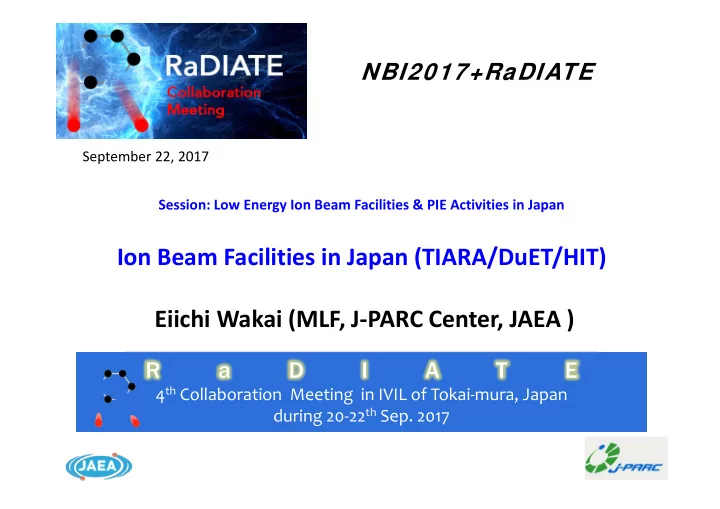

NBI2017+RaDIATE September 22, 2017 Session: Low Energy Ion Beam Facilities & PIE Activities in Japan Ion Beam Facilities in Japan (TIARA/DuET/HIT) Eiichi Wakai (MLF, J‐PARC Center, JAEA ) R R a a D D I I A A T T E E 4 th Collaboration Meeting in IVIL of Tokai ‐ mura, Japan 4 th Collaboration Meeting in IVIL of Tokai ‐ mura, Japan during 20 ‐ 22 th Sep. 2017 during 20 ‐ 22 th Sep. 2017
Content 1. Research Background 2. Introduction of Ion Beam Facilities in Japan (TIARA/DuET/HIT) 3. Some Results 4. Summary
1. Research Background Merit of Low Energy Multiple‐Ion Beam Experiment: (1) Higher dpa rate (about 5 dpa/h) (2) No radioactivity (3) Relatively low cost operation (4) He/dpa and H/dpa can be controlled for the purpose
1. Research Background Irradiation hardening can be estimated from microstructural analysis. Radiation hardening estimated from Tensile Properties TEM images Microstructures E. Wakai, et al.,
2. Introduction of Ion Beam Facilities in Japan(TIARA/DuET/HIT) Triple Ion Irradiation Facility of JAEA (QST at present) Takasaki city, Gunma‐prefecture, Japan
2. Introduction of Ion Beam Facilities in Japan(TIARA/DuET/HIT) Triple Ion Irradiation Facility of JAEA (QST at present) Specimen H + (Ion implanter) Degrader He H Fe 10.5 MeV Fe 2+ , 1.05 MeV-He + , 0.38 MeV-H +
2. Introduction of Ion Beam Facilities in Japan(TIARA/DuET/HIT) Triple Ion Irradiation Facility of JAEA (QST at present)
2. Introduction of Ion Beam Facilities in Japan(TIARA/DuET/HIT) DuET Facility of Kyoto Univ. Two beam lines such as Fe ion beam and He ion beam
2. Introduction of Ion Beam Facilities in Japan(TIARA/DuET/HIT) HIT Facility of Univ. of Tokyo (Tokai‐mura, Ibaraki)
3. Some Results TEM Specimen prepared by Focused Ion Beam 約10nm Au thin plate 11
3. Some Results Swelling of F82H under Dual or Triple Ion Irradiation (10.5 MeV Fe2+, 1.05 MeV-He+, 0.38 MeV-H+) Dual beams Triple beams Triple beams (10 appm-He/dpa) (10 appm-He/dpa, 40 appm-H/dpa) (100 appm-He/dpa, 500 appmH/dpa) (a) (b) (c) 50 nm 1.2% 3.2% 0.08% Cavities formed in F82H irradiated at 470 o C to 50dpa at the depth of around 1 m. E. Wakai, et al., “Effect of triple ion beams in ferritic/martensitic steel on swelling behavior”, Journal of Nuclear Materials 307‐311 (2002), pp.278‐282.
3. Some Results 470 o C 600 o C 50 dpa Triple (Spallation Spallation Triple (Fusion) Dual (Fusion) (triple) 10 1 1.0E+15 Pre-irradiation 5 200nm level Density of dislocation (m -2 ) 200nm Fusion 10 1 (triple) 1.0E+14 4 200nm 200nm Fusion 10 1 1.0E+13 3 (dual) 470 o C 600 o C 100nm 200nm Irradiation Temperature( o C) Dislocation of F82H under Dual or Triple Ion Irradiation E. Wakai, et al., “Effect of triple ion beams in ferritic/martensitic steel on swelling behavior”, Journal of Nuclear Materials 307‐311 (2002), pp.278‐282.
3. Some Results TIARA Triple Ion Beam Experiment Triple ion beam Fusion condition 10 (He/dpa, H/dpa) Triple ion beams Spallation condition (%) Swelling (%) Material: F82H steel (He/dpa, H/dpa) 1 (Fe‐8Cr‐2W‐0.1C‐0.04Ta Swelling ferritc/martenstic steel) for fusion structure material, 0.1 50 dpa Dual ion beams ( He/dpa) 0.01 400 500 600 Irradiation Temperature Irradiation emperature ( ℃ )
H measurement in nuclear resonance method (from 15 N(H, ) 12 C ) gannma‐ray Counts (arb. Unit) H Concentration (at%) H Implanted depth Depth from surface
Swelling Reduction for F82H steel 3.2% 3.2% 1.4% 1.4% 0.5% 0.5% (a) (b’) (b’) (c) (c) (b) (b) (b’) (b’) (c) (c) 16 50nm 50 nm 50 nm F82H-std F82H-std +50%CW(1) +50%CW(1) +50%CW(2) +50%CW(2) +90appm C +90appm C Swelling can be reduced by CW and carbon concentration
Model Fe‐Cr Alloy: Swelling Behavior by Ion Irradiation (TIARA of JAEA) Number Density of Cavity Averaged Diameter of Cavity Swelling (%) (×10 21 ) (nm) 5 2 100 9Cr 9Cr 9Cr He He 12Cr He 12Cr 12Cr H H H He+H He+H He+H Dislocation (x10 13 /m 2 ) Swelling depending Number Density of 4 on Temp., Dual & 3 Triple 2 1 9C r 12Cr He H He+H 17 By Tanaka
Synergistic effect of He, H, and Dpa in V Materials: V TIARA Multi‐ion beam experiment N.Sekimura et al. Journal of Nuclear Materials 283-287(2000)
Nano‐Indentation Measurement 5.0 微小押し込み硬さ (GPa) 照射後硬さ 4.5 照射硬化 照射前硬さ 4.0 Welded Base 3.5 溶接金属側 Metal Metal 変態線 母材側 Region 3.0 2.5 -4 2 -3 -2 -1 0 1 TIG Welded F82H irradiated 変態線からの距離 (mm) to 5 dpa at 300C in tiara
Hardening Behavior, F82H, 100dpa, 360℃ 10.0 1200 Micro-Hardness (GPa) neutron irradiation (HFIR, 300 C) 1000 8.0 800 y (MPa) 600 6.0 Ion irradiation 400 (10.5MeV Fe, 360 C) 200 4.0 750 C-tempered Fe/He dual 0 800 C-tempered Fe single 2.0 0 25 50 75 100 125 Irradiation dose(dpa) M. Ando (QST/JAEA)
HIT Ion Irradiation (SUS316) (N. Okubo) 1 dpa 10 dpa Dislocation(No Cavity) Cavity Dislocation 0 He-appm/dpa 1 10
HIT Ion Irradiation (SUS316) (N. Okubo) Increment of hardness
SAW (Surface Acoustic Wave) Measurement Technique for detection of radiation hardening S.-i. Kitazawa et al. Radiation Physics and Chemistry, 127(2016)264–268
SAW (Surface Acoustic Wave) Measurement Technique for detection of radiation hardening
SAW (Surface Acoustic Wave) Measurement Technique for detection of radiation hardening
4. SUMMARY As low energy ion beam facilities with multiple ion beams in Japan, TIARA of JAEA (QST), DuET of Kyoto Univ., and HIT of Univ. of Tokyo were shown. The merits of low energy multiple‐Ion beam experiment are given as below; (1) Higher dpa rate (about 5 dpa/h), (2) No radioactivity, (3) Relatively low cost operation, (4) He/dpa and H/dpa can be controlled for the purpose The synergistic effect of He, H, dpa on swelling behavior were mainly shown in F82H, model alloy Fe‐Cr, and V. Some analysis techniques were introduced such as SAW technique, nano indentation, H measurement in nuclear resonance method (from 15 N(H, ) 12 C ) for radiation damage.
Recommend
More recommend